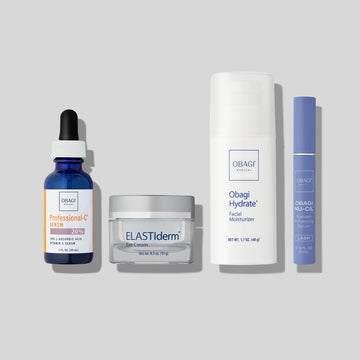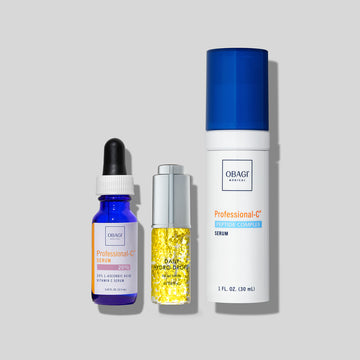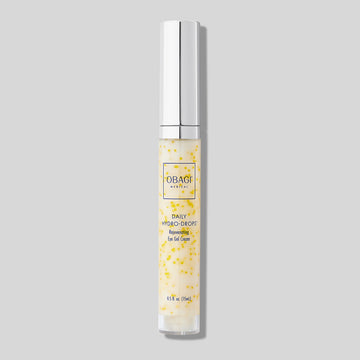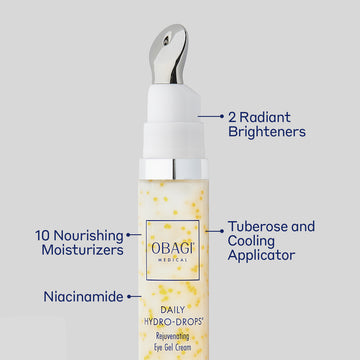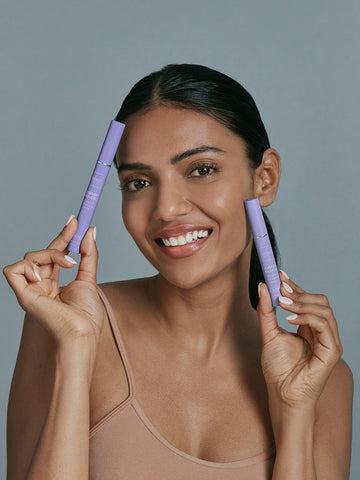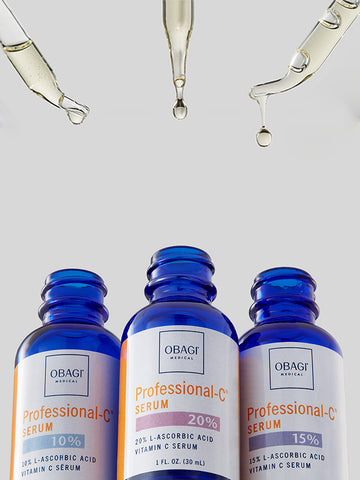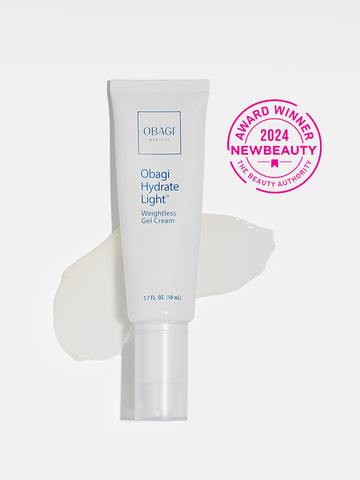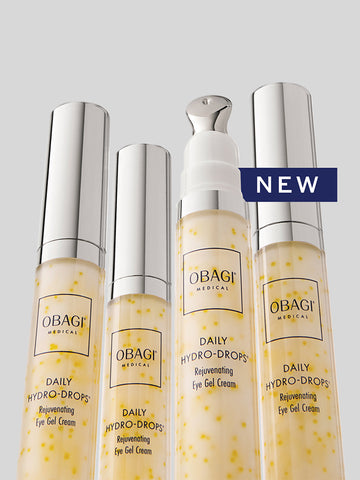Using sunscreen, skincare, and sun protection to maximize your skin health
Even a small amount of sun-exposure has the potential to damage your skin, make it look older via photoaging, and increase your risk of skin cancer.
The sun damages your skin in more ways than you may realize. Do more to protect yourself by learning about how your skin is damaged and which skincare solutions are the best for protecting and repairing that damage.
How skin is damaged by sun
Skin damage caused by light from the sun is known as photodamage. Not all light from the sun is hazardous. There are three specific types of light that do most of the damage to the skin.
Types of skin-damaging rays
Damaging rays can be separated into categories based on the frequency of light. HEV (High energy visible) rays have the longest wavelength of 400nm (nanometers). Next longest is UVA at 315nm and 280 nm for UVB. There is another type of damaging ray — UVC which has a wavelength of around 200nm, but the earth’s ozone prevents most of it from entering the earth’s atmosphere.
Keep in mind that damaging light doesn’t just come from the sun. HEV light, also known as blue-light, can come from television, computer, or phone screens.
Types of sun damage
When you think of skin damage caused by the sun, you immediately think of visible examples such as sunburn, wrinkles, and photoaging, but damage takes many forms including some that aren’t immediately apparent.
Types of sun damage:
Sunburn - Technically a radiation burn, sunburn results in tender, hot skin as your body tries to repair itself. Mild cases involve burns to the outermost layer of skin, the epidermis, but extreme cases may involve the lower layer of skin, the dermis. The symptoms of a sunburn typically last for less than a week.
DNA damage - UVB rays directly impact DNA and cause damage that may involve single mutations or loss of genetic material via double strand breaks. UVA, UVA and HEV rays can also damage the skin indirectly by first getting absorbed by chromophores (any substance that absorbs light) and then creating reactive oxygen species (ROS) which in turn also damage DNA, causing double strand breaks.
When DNA is damaged, your body’s cells may be unable to create proteins correctly. They can have mutations, errors with cell replication, and eventually develop cancer.
A visible sign of DNA damage of UVB radiation are rough patches of skin known as actinic keratosis. This damage can present as reddish marks or dark marks that are precancerous and can turn into squamous cell carcinoma.
In addition to the indirect damage ROS causes through DNA mediation, it also directly damages the structure of your skin, causing proteins to misfold and lipid peroxidation, which can break cell membranes, causing additional damage.
Dry skin - The physical process of being exposed to light can draw moisture and oils from your skin, indirectly leading to damage.
Hyperpigmentation - Excessive exposure to sunlight is the primary reason for hyperpigmentation since sunlight stimulates melanin production, which serves as your skin's inherent defense against UV rays. While melanin shields you from harmful sun rays, overexposure can disturb this balance, resulting in hyperpigmentation. In addition, Vitamin C regulates production of the skin’s pigmentation compound melanin, but it is decreased in your skin by sun exposure. When melanin is unregulated, the body can develop sun spots. UVA, UVB, and HEV radiation can all contribute to hyperpigmentation.
Damage to collagen - UVA rays damage collagen because their longer wavelength enables them to penetrate deeper into the dermis where collagen is stored. With the loss of collagen, wrinkles become more apparent and skin elasticity is reduced.
Preventing sun damage to skin
The best way to prevent sun damage is to limit exposure. Avoid direct sunlight in the middle of day between the hours of 10am and 4pm.
Recognize that the intensity of the sun varies widely based on the season. Going outside in the sun at noon in wintertime is very different from going outside at noon in summer because the UV rays are stronger in July and weakest in December. To get an estimate of the total amount of rays you’re exposing your body to check the UV index.
You can’t always avoid the sun though, sometimes you have to go outside when it’s not ideal. In these cases, protect your skin with clothing and sunscreen.
Clothing vs. sunscreen for skin protection
Sunscreen is often thought of as the first go-to solution for protecting your skin from the sun, but you should also prioritize protective clothing.
While sunscreen only lasts for a few hours and needs to be reapplied, clothing maintains a constant amount of protection. Clothing also can offer much higher levels of skin protection. Darkly colored and tightly woven fabric blocks more light. Dark denim has a UPF factor of 1700, which effectively blocks out all solar radiation.
Sunscreen is also limited in what frequencies of light it blocks. While chemical-based sunscreen is effective at blocking UVB rays, it doesn’t block HEV. Mineral sunscreens provide some limited protection from HEV and blue-light sources.
Where sunscreen really shines is protecting places that aren’t usually covered by clothing. These are also the most common places of extreme sun damage and skin cancer — on the head, face, neck, back of hands. For these locations, sunscreen is potentially the best option.
Understanding sun protection - SPF vs. UPF
Protective clothing and sunscreen are rated on scales based on how much protection they can provide.
UPF or ultraviolet protection factor measures the amount of protection from both UVA and UVB rays.
SPF or sun protection factor measures protection from UVB rays, which are the main source of damage. SPF number is a multiplier of how long it would take to get sunburned vs. not using SPF.
Top ingredients for improving appearance of sun-damaged skin
While sun damage to the skin cannot be fully reversed, there are topical products you can use to improve the appearance of the damage.
Top ingredients for photodamaged skin:
Sunscreen has been shown to be more effective when applied with vitamin C. The skin naturally contains vitamin C. Sun exposure reduces levels of vitamin C. Giving your skin vitamin C helps it maintain proper processes. As an antioxidant it fights ROS, capturing and neutralizing reactive molecules before they can do damage. For best results, combine sunscreen with vitamin C and vitamin E to maximize antioxidant benefits.
Niacinamide is an antioxidant that is frequently used in hydrating serums. When used properly, it can help offset dehydration caused by the sun and reduce the appearance of wrinkles. There is also evidence that it may decrease the peroxidation of lipids, a process that can oxidize sebum on the skin, leading to formation of comedones and acne.
Another hydrating option that helps preemptively reduce sun damage is hyaluronic acid. As a humectant, it captures moisture. To prevent it from drying out your skin, always keep it sealed in with a moisturizer.
You can further support your skin by regular use of moisturizers. While moisturizers without SPF do not protect skin against sun damage, skin that isn’t properly nourished will experience compounded negative effects when overexposed to the sun.
Studies have shown that retinoids may help shrink actinic keratosis precancerous lesions on the skin that result from excessive sun exposure. Retinoids tretinoin and adapalene showed the most potential for treating actinic keratosis.
RESOURCES:
1. National Library of Medicine. Molecular Mechanisms of Ultraviolet Radiation-Induced DNA Damage and Repair. https://www.ncbi.nlm.nih.gov/pmc/articles/PMC3010660/
2. American Academy of Dermatology Association. ACTINIC KERATOSIS: SIGNS AND SYMPTOMS. https://www.aad.org/public/diseases/skin-cancer/actinic-keratosis-symptoms
3. Skin Cancer Foundation. Photoaging: What You Need to Know About the Other Kind of Aging. https://www.skincancer.org/blog/photoaging-what-you-need-to-know/
4. Environmental Protection Agency. Sun Safety Monthly Average UV Index 2006-2023. https://www.epa.gov/sunsafety/sun-safety-monthly-average-uv-index-2006-2023
5. Skin Cancer Foundation. Sun-Protective Clothing. https://www.skincancer.org/skin-cancer-prevention/sun-protection/sun-protective-clothing/
6. National Library of Medicine. The Use of Retinoids for the Prevention and Treatment of Skin Cancers: An Updated Review. https://www.ncbi.nlm.nih.gov/pmc/articles/PMC9603842/
